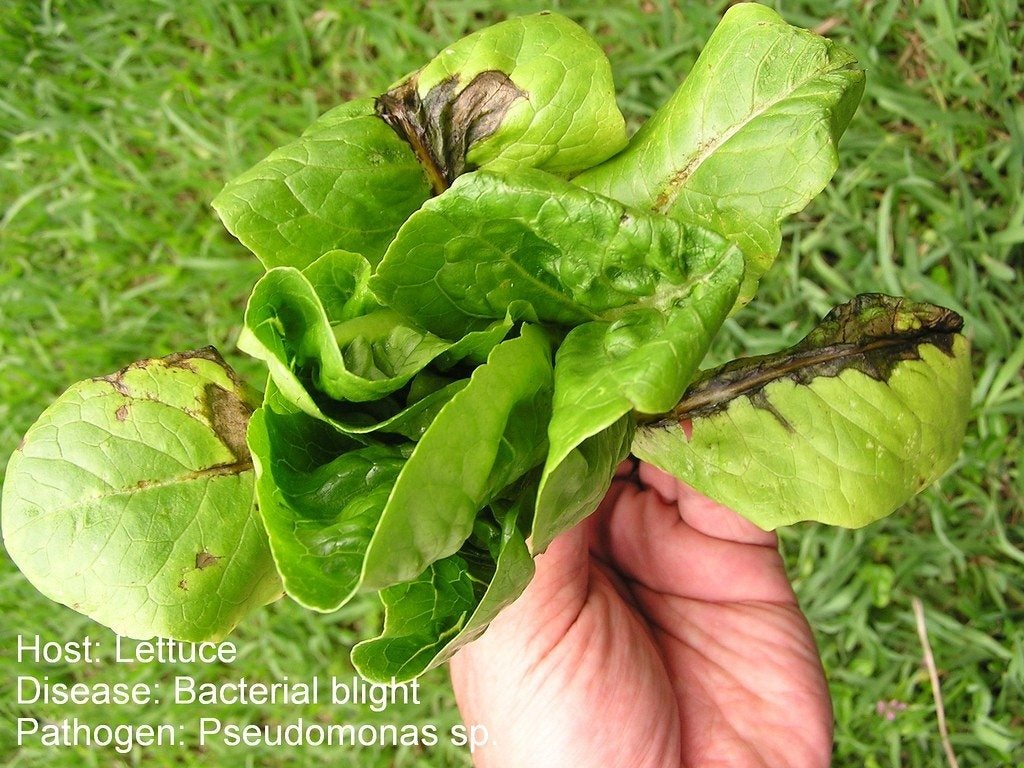Common Diseases Affecting Lettuce Plants: Tips For Treating Lettuce Diseases

If you're new to gardening or some tiny hands in your household could use a summer project, growing lettuce is a simple vegetable to grow with minimal problems. The few issues that do crop up are usually easily solved with simple organic solutions, planting in well-drained soil with adequate nutrients, spacing correctly, and maintaining consistent moisture content.
Diseases Affecting Lettuce Plants
Diseases affecting lettuce plants are either bacterial or fungal. Fungal lettuce diseases, such as damping off or sclerotinia drop (white mold), are caused by soil borne fungi that thrive in cool, damp soil and are primarily lettuce seedling diseases. Treat these lettuce diseases by spacing the plants apart to provide airflow, and by reducing the amount of irrigation the seedlings receive. If you live in an area of more consistent precipitation and cooler temperatures, try planting fungal disease resistant lettuce such as ‘Optima' to prevent lettuce seedling diseases from taking hold. Bottom rot, another fungal lettuce disease caused by Rhizoctonia solani, attacks more mature plants. Lesions appear on the plant at the midrib and leaf blade, causing rotting during warm, wet conditions. Bacterial leaf spot appears as small, angular lesions and progresses to larger lesions and necrotic areas, which dry out and eventually collapse. Sporulating downy mildew, caused by Bremia lactucae, also causes necrotic lesions but affects the older leaves of the lettuce first. The bacterium Rhizomonas suberifaciens afflicts the roots, causing them to become very brittle and resulting in small head sizes.
Lettuce Disease Control
Of course, there's a variety of pests that assault lettuce plants, and many will spread common lettuce diseases as they move from plant to plant. Check around the lettuce plant for uninvited guests to potentially eliminate disease of any kind as the cause for deterioration. Most pests can be eliminated by the use of insecticidal soap, introduction of beneficial insects, planting nectar-rich plants (like cilantro or sweet alyssum), spreading organic bait and the use of row covers. If you have established that the frail, fading lettuce is not the result of pests but of disease, the following tips for lettuce disease control may help:
- Treating lettuce diseases may be a matter of sowing disease or fungal resistant varieties, planting the appropriate variety for your climate at the correct time of year, appropriate spacing and irrigation.
- For some diseases affecting lettuce plants, weed control is essential as is crop rotation.
- Planting lettuce in raised beds may also be effective in warding off some pathogens.
- Lastly, a chemical control measure may be used. Of course, always follow the manufacturer's instructions for application.
Gardening tips, videos, info and more delivered right to your inbox!
Sign up for the Gardening Know How newsletter today and receive a free copy of our e-book "How to Grow Delicious Tomatoes".

Amy Grant has been gardening for 30 years and writing for 15. A professional chef and caterer, Amy's area of expertise is culinary gardening.
-
 8 Perfect Flowers To Plant With Tomatoes To Boost Yields & Banish Pests
8 Perfect Flowers To Plant With Tomatoes To Boost Yields & Banish PestsDon’t forget flowers when choosing companion plants for your tomato beds or pots. These pretty, fragrant flowers add beauty but are also highly beneficial.
By Mary Ellen Ellis
-
 Want The Longest Lasting Hydrangea Flowers? Grow These 8 Panicle Hydrangea Varieties
Want The Longest Lasting Hydrangea Flowers? Grow These 8 Panicle Hydrangea VarietiesFor ornamental shrubs that deliver the longest flowering seasons with plush blooms and delicate hues, these panicle hydrangea varieties are essential in your yard
By Tonya Barnett